The Release of CCZA Ransomware & Why You Should Protect Your Computer
Contents
CCZA ransomware is a malicious computer virus that aims to encrypt all data on the target system. This virus is associated with the infamous STOP/DJVU cybercriminal gang which has been releasing file-encrypting malware regularly. Once this ransomware infects a computer and encrypts files contained in it, the owner will be asked to pay huge sums of money as ransom before they are issued decryption tools. Also, .ccza extension would be attached to encrypted files as a means of identifying them. For example, files there were hitherto saved as 1.jpg, or 2.jpeg now become 1.jpg.ccza and 2.jpeg.ccza respectively. Files that could be affected include documents, pictures, and videos etc.
The emergence of yet another malware from the notorious STOP/DJVU ransomware family is now a cause for concern for every computer user. This group has consistently remained a threat in the past few years. They prey for victims by uploading fake software versions to various rogue sites. These are filled with malware that encrypts all data on the computer and then leaves notes demanding to pay a ransom.

The virus drops ransom-demanding note
Once the access has been taken over the victim’s files, cybercriminals would at this point, release ransom messages known as _readme.txt. Such notifications would claim that the ransomware attack was successful and that the victim would permanently lose all files except excerpt they accede to their ransom demand, enabling them to forward the decryption tools. In anticipation of the victim’s response, they would drop two emails, namely: support@bestyourmail.ch, datarestorehelp@airmail.cc.
Such a situation is always dicey for victims, especially if they have no backup prior to the ransom attack. Depending on how important the files may be to them, some victims might try to reach out to those behind the attack in an attempt to have their files restored.
However, once they email the cybercriminals, they would instantly assume that the files are very important to the victim and thus would immediately respond by stating the amount that has to be paid as a ransom fee, which they usually fix as high as $980. To hasten the victim and make them pay ASAP, they would add a caveat that half of the quoted ransom fee i.e. $480 would be acceptable provided the victim is able to pay within 3 days of receiving notification to do so.
They would also insist that ransom payment must be made via cryptocurrency, whereby the victim should wire the exact amount quoted in the dollar to their crypto wallet. The apparent reason why they only accept this medium of payment is simply that it protects their real identity from being revealed.

Whatever is the case, it is in the best interest of victims never to communicate with virtual harassers, and neither are they supposed to pay ransom in any form. This recommendation is supported by the FBI and other reputable security organizations. Based on our own studies, we came up with reasons why paying the ransom is bad in its entirety, and we reproduced them below:
- Paying ransom is an unnecessary gamble since there is no guarantee that cybercriminals would keep to their own part of the bargain, in reality, they don’t.
- You make yourself vulnerable to future ransomware attacks when you pay the ransom because they’re greedy and keep coming for more.
- Paying ransom is considered illegal in specific countries.
- Paying ransom to cybercriminals enables them to expand their criminal organization, thereby putting others at risk.
This virus arrives in tandem with Trojans
Even though much has been said about the primary virus, there are other risks as well. Secondary malware often accompanies it as well, and they’re known as Remote Access Trojans or RATs for short. Their function is slightly different and is used by cybercriminals in stealing highly sensitive personal information like banking details, software login details, cryptocurrency wallets, and passwords, etc. The victim might not even be aware that they’ve been compromised until they use it to commit further criminal acts.
Due to risks highlighted above, it is very important to remove CCZA ransomware virus as soon as it is detected in your computer. You can get a reliable antivirus and set up your computer through Safe Mode with Networking option before activating it. You’re advised to use only antivirus software that has been trusted and considered secure. You may also download RESTORO and use it to repair some of the damaged Windows OS components and files wherever possible.
Ransomware Summary
| Name | CCZA Ransomware Virus |
| Type | Ransomware; Crypto-malware; Virtual Extortion Virus |
| Family | STOP/DJVU |
| Encryption type | RSA 2048 + Salsa20 |
| Previous versions | KAAA, BGJS, BGZQ (find full list here) |
| Version | 539th |
| Extension | .ccza |
| Cybercriminal emails | support@bestyourmail.ch, datarestorehelp@airmail.cc |
| Additional malware dropped | Azorult or Vidar Trojan |
| Damage | The ransomware uses encryption to maliciously modify all files on the PC and marks their original names with .ccza extension. Ransom notes called as _readme.txt will be dropped in every computer folder. This piece of malware usually drags VIDAR Stealer alongside it and also eliminates VSS from the system. On top of that, it tends to modify Windows HOSTS file to restrict computer user’s access to cybersecurity-related websites online. |
| Ransom note | _readme.txt |
| Ransom demand | $490-$980 in Bitcoin |
| Distribution | Victims often download this ransomware along illegal torrent downloads, cracked software, activators, key generators or tools like KMSPico. |
| Known software cracks to contain this malware | Corel Draw, Tenorshare 4ukey, Adobe Photoshop, Cubase, Adobe Illustrator, Internet Download Manager, Tally, League of Legends. |
| Detection names | Ransom:Win32/StopCrypt.PAL!MTB (Microsoft), Trojan.Crypt (A) (Emsisoft), HEUR:Trojan-Ransom.Win32.Stop.gen (Kaspersky), Trojan.GenericKD.47850419 (BitDefender), Trojan.MalPack.GS (Malwarebytes), ML.Attribute.HighConfidence (Symantec) see all detection name variations on VirusTotal |
| Removal | Remove ransomware and related malware from your PC using trustworthy software. To repair virus damage on Windows OS files, consider scanning with RESTORO (secure download link). |
REPAIR VIRUS DAMAGE
Scan your system for FREE to detect security, hardware and stability issues. You can use the scan results and try to remove threats manually, or you can choose to get the full version of software to fix detected issues and repair virus damage to Windows OS system files automatically. Includes Avira spyware/malware detection & removal engine.
The screenshot provided below displays how ransomware-affected files appear. In addition, you can see that the virus saves a copy of the ransom note in each directory.

Protect Your Computer from Getting Infected With CCZA Ransomware Virus
What makes the difference between becoming a victim of a ransomware attack and staying safe depends largely on the attitude of the computer user. From a general perspective, some computer users are careful and make conscious efforts to protect their computers while some others are carefree with their activities. The latter groups often end up as victims of ransomware attacks because they indulge in risk factors that expose them, such as going to online torrent platforms, using P2P in sharing software, opening emails and attachments indiscriminately, etc.
Computer users that habitually download software content from online torrent platforms should desist from doing so because cybercriminals often upload cloned software contents that are embedded with malware. They use them as bait to spread malware to as many computers as possible. When such malware-laden software contents are downloaded, they eventually result in a ransomware attack. On the contrary, it is safer and more dignified to obtain software contents through the official channels instead of trying to cut corners.
From our studies, we discovered that cybercriminals usually pirate software copies that are in high demand because their aim is to get as many victims as possible. Here are some of the software contents cybercriminals often clone and upload to online torrent platforms:
- Adobe Illustrator;
- Corel Draw;
- AutoCad;
- Adobe Photoshop;
- MS Office;
- Need for Speed;
- VMware Workstation;
- League of Legends;
- Internet Download Manager.
Some computer users have formed the habit of trying to bypass the legitimate channels they’re supposed to follow when downloading needed software, but it could have disastrous consequences. Visiting the appropriate websites designated by the original content producers when sourcing for software needs is the right thing to do. You shouldn’t be discouraged by the fees they request because it takes a lot to produce some of this software and they need to recoup what they’ve invested in research and development.
Emails and attachments shouldn’t be opened except if their origin is confirmed to be genuine. To be sure, you should consider if you have any business with such email or attachment in the first place.
Check to know if the address was spoofed to deceive you. Does it have a title that appears bogus? These are red flags that shouldn’t be ignored.
Peradventure, you’re already a victim; it calls for weighty considerations. Don’t go about searching desperately for decryption solutions because they rarely exist. Instead, look for any available backup and replace lost files.
How to remove CCZA ransomware virus and recover data
The user should log into the infected system through the Safe Mode with Networking option. Afterward, we advise users to activate and scan the infected computer genuine antivirus software. When you’re done removing the virus, there are other actions you’re expected to take, as listed below:
- Restore lost files using an available backup (if there are any).
- Change all passwords used on the compromised computer.
- Report the incident to the authorities for possible action.
- Consider downloading RESTORO to identify and fix virus damage (wherever possible) automatically.
Lastly, taking proactive measures, as elaborated in this article, is the best way to safeguard your computer. However, in all you do, don’t try to reason with cybercriminals because it never ends well.
OUR GEEKS RECOMMEND
Our team recommends removing malware using a professional antivirus software.
REMOVE THREATS WITH ROBUST ANTIVIRUS

Get INTEGO ANTIVIRUS for Windows to remove ransomware, Trojans, adware and other spyware and malware variants and protect your PC and network drives 24/7. This VB100-certified security software uses state-of-art technology to provide protection against ransomware, Zero-Day attacks and advanced threats, Intego Web Shield blocks dangerous websites, phishing attacks, malicious downloads and installation of potentially unwanted programs.
Use INTEGO Antivirus to remove detected threats from your computer.
GeeksAdvice.com editors select recommended products based on their effectiveness. We may earn a commission from affiliate links, at no additional cost to you. Learn more.
CCZA Ransomware Virus Removal Guidelines
Method 1. Enter Safe Mode with Networking
Step 1. Start Windows in Safe Mode with Networking
Before you try to remove CCZA Ransomware Virus virus, you must start your computer in Safe Mode with Networking. Below, we provide the easiest ways to boot PC in the said mode, but you can find additional ones in this in-depth tutorial on our website – How to Start Windows in Safe Mode. Also, if you prefer a video version of the tutorial, check our guide How to Start Windows in Safe Mode on Youtube.
Instructions for Windows XP/Vista/7 users
- First of all, turn off your PC. Then press the Power button to start it again and instantly start pressing F8 button on your keyboard repeatedly in 1-second intervals. This launches the Advanced Boot Options menu.
- Use arrow keys on the keyboard to navigate down to Safe Mode with Networking option and press Enter.

Instructions for Windows 8/8.1/10/11 users
- Open Windows Start menu, then press down the Power button. On your keyboard, press down and hold the Shift key, and then select Restart option.

- This will take you to Windows Troubleshoot screen. Choose Troubleshoot > Advanced Options > Startup Settings > Restart. Tip: If you can't find Startup Settings, click See more recovery options.

- In Startup Settings, press the right key between F1-F9 to enter Safe Mode with Networking. In this case, it is the F5 key.

Step 2. Remove files associated with the virus
Now, you can search for and remove CCZA Ransomware Virus files. It is very hard to identify files and registry keys that belong to the ransomware virus, Besides, malware creators tend to rename and change them repeatedly. Therefore, the easiest way to uninstall such type of a computer virus is to use a reliable security program such as INTEGO Antivirus. For virus damage repair, consider using RESTORO.
Special Offer
Compatibility: Microsoft Windows
See Full Review
RESTORO is a unique PC Repair Tool which comes with an in-built Avira scan engine to detect and remove spyware/malware threats and uses a patented technology to repair virus damage. The software can repair damaged, missing or malfunctioning Windows OS files, corrupted DLLs, and more. The free version offers a scan that detects issues. To fix them, license key for the full software version must be purchased.
Method 2. Use System Restore
In order to use System Restore, you must have a system restore point, created either manually or automatically.
Step 1. Boot Windows in Safe Mode with Command Prompt
Instructions for Windows XP/Vista/7 users
- Shut down your PC. Start it again by pressing the Power button and instantly start pressing F8 button on your keyboard repeatedly in 1-second intervals. You will see Advanced Boot Options menu.
- Using arrow keys on the keyboard, navigate down to Safe Mode with Command Prompt option and press Enter.

Instructions for Windows 8/8.1/10/11 users
- Launch Windows Start menu, then click the Power button. On your keyboard, press down and hold the Shift key, and then choose Restart option with the mouse cursor.

- This will take you to Windows Troubleshoot screen. Choose Troubleshoot > Advanced Options > Startup Settings > Restart. Tip: If you can't find Startup Settings, click See more recovery options.

- In Startup Settings, press the right key between F1-F9 to enter Safe Mode with Command Prompt. In this case, press F6 key.

Step 2. Start System Restore process
- Wait until system loads and command prompt shows up.
- Type cd restore and press Enter, then type rstrui.exe and press Enter. Or you can just type %systemroot%system32restorerstrui.exe in command prompt and hit Enter.

- This launches System Restore window. Click Next and then choose a System Restore point created in the past. Choose one that was created before ransomware infection.

- Click Yes to begin the system restoration process.
After restoring the system, we recommend scanning the system with antivirus or anti-malware software. In most cases, there won't be any malware remains, but it never hurts to double-check. In addition, we highly recommend checking ransomware prevention guidelines provided by our experts in order to protect your PC against similar viruses in the future.
Alternative software recommendations
Malwarebytes Anti-Malware
Removing spyware and malware is one step towards cybersecurity. To protect yourself against ever-evolving threats, we strongly recommend purchasing a Premium version of Malwarebytes Anti-Malware, which provides security based on artificial intelligence and machine learning. Includes ransomware protection. See pricing options and protect yourself now.

System Mechanic Ultimate Defense
If you're looking for an all-in-one system maintenance suite that has 7 core components providing powerful real-time protection, on-demand malware removal, system optimization, data recovery, password manager, online privacy protection and secure driver wiping technology. Therefore, due to its wide-range of capabilities, System Mechanic Ultimate Defense deserves Geek's Advice approval. Get it now for 50% off. You may also be interested in its full review.

Disclaimer. This site includes affiliate links. We may earn a small commission by recommending certain products, at no additional cost for you. We only choose quality software and services to recommend.
Decrypt CCZA files
Fix and open large CCZA files easily:
It is reported that STOP/DJVU ransomware versions encrypt only the beginning 150 KB of each file to ensure that the virus manages to affect all files on the system. In some cases, the malicious program might skip some files at all. That said, we recommend testing this method on several big (>1GB) files first.
- Create a copy of encrypted file to a separate folder using Copy > Paste commands.
- Now, right-click the created copy and choose Rename. Select the CCZA extension and delete it. Press Enter to save changes.
- In the prompt asking whether you want to make the changes as file might become unusable, click OK.
- Try opening the file.
STOP/DJVU decryption tool usage guide
STOP/DJVU ransomware versions are grouped into old and new variants. CCZA Ransomware Virus is considered the new STOP/DJVU variant, just like KAAA, BGJS, BGZQ (find full list here). This means full data decryption is now possible only if you have been affected by offline encryption key. To decrypt your files, you will have to download Emsisoft Decryptor for STOP DJVU, a tool created and maintained by a genius security researcher Michael Gillespie.
Note! Please do not spam the security researcher with questions whether he can recover your files encrypted with online key - it is not possible.
In order to test the tool and see if it can decrypt CCZA files, follow the given tutorial.
- Download the decryption tool from Emsisoft.
- Click the little arrow next to your download and choose Show in Folder.
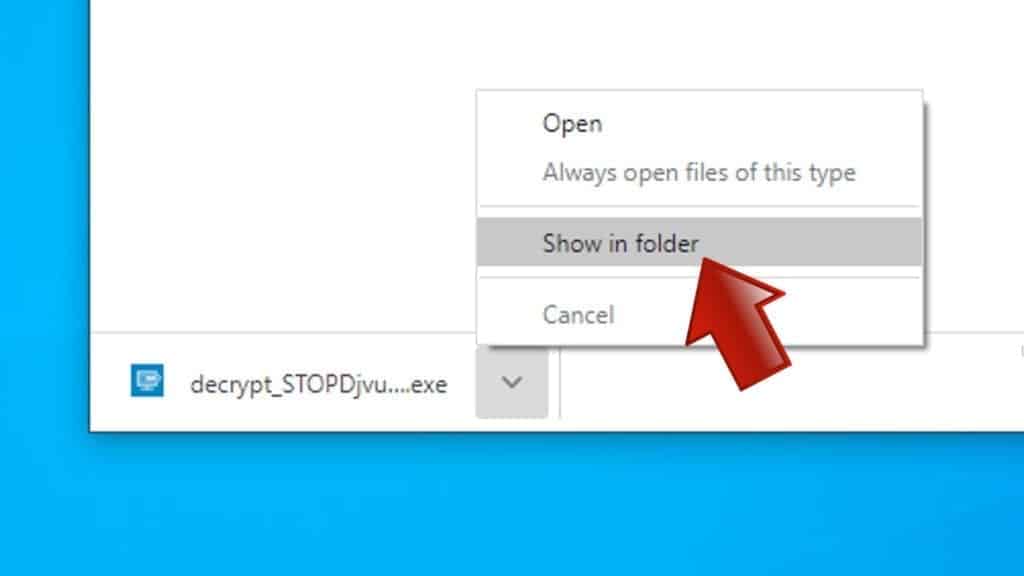
- Now, right-click the file and choose Run as Administrator. If asked, enter administrator's password.
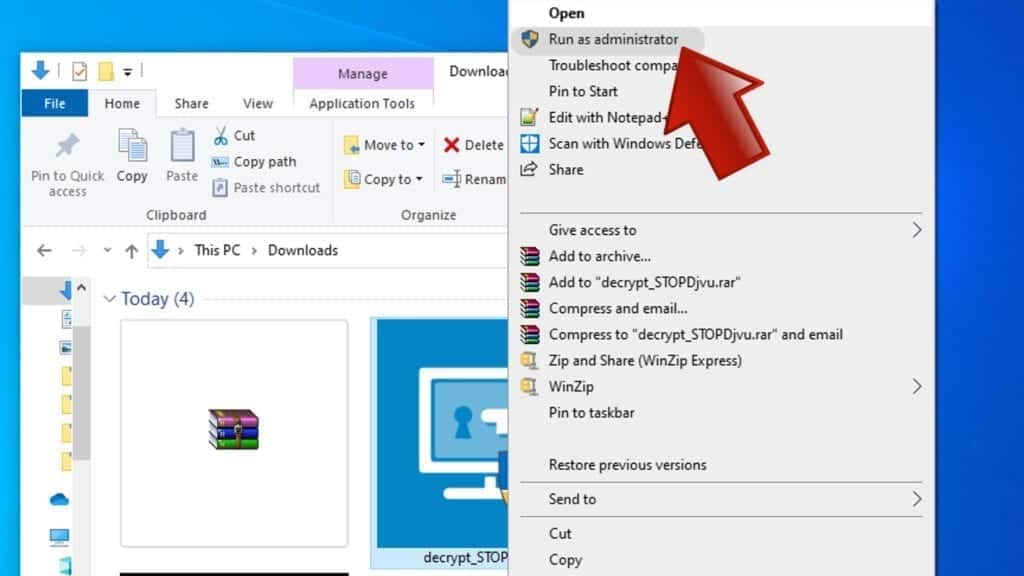
- In UAC window, click Yes.
- Click Yes to agree to software terms in both windows.
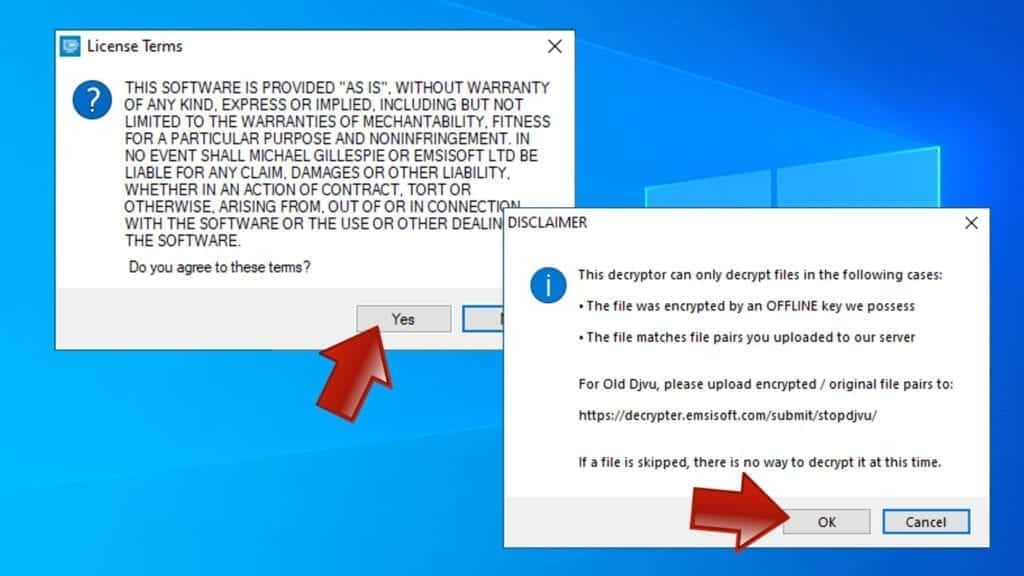
- The tool will automatically include C:// disk as a location to decrypt. The file recovery tool will prepopulate the locations to scan, including connected data storage drives or network drives. Click Add folder if you wish to add additional locations.
In Options tab, you can choose to keep encrypted file copies. We recommend leaving this option selected, especially if you do not know if the decryption tool will work.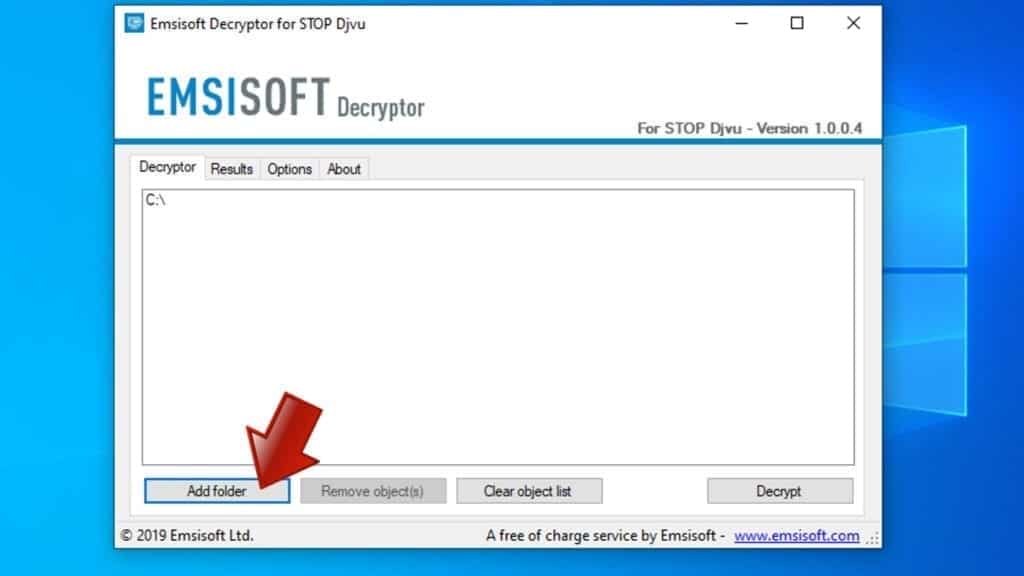
- Click Decrypt to start restoring CCZA files. You will see the progress in the Results tab. Here, you can see messages from the tool, such as whether the decryption procedure is successful, or you need to wait for an update.
You might also be informed that online key was used to encrypt your files. In such case, the decryption tool won't work for you, and the only way to recover your files is to use a data backup.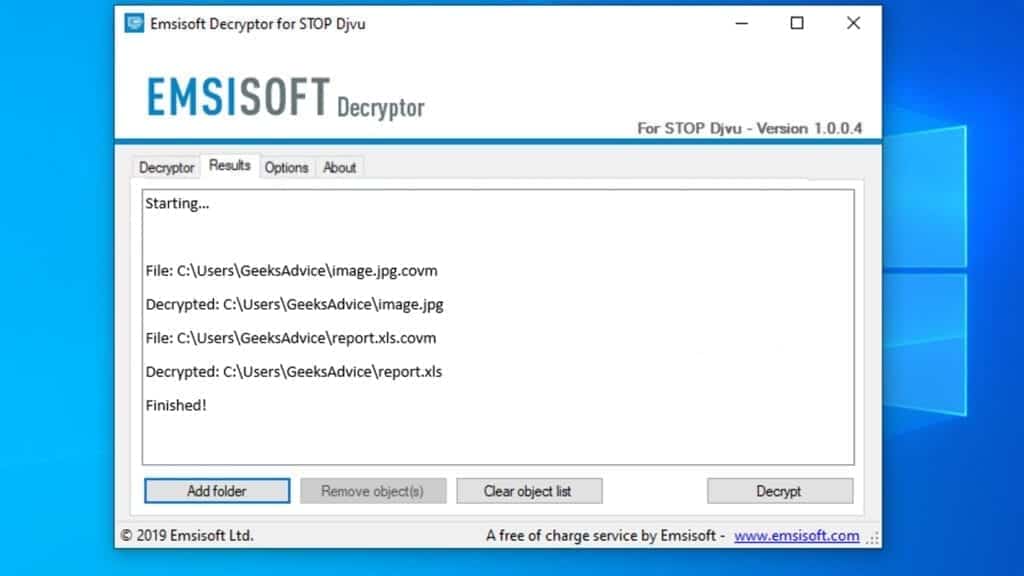
Meanings of decryptor's messages
The CCZA decryption tool might display several different messages after failed attempt to restore your files. You might receive one of the following messages:
Error: Unable to decrypt file with ID: [example ID]
This message typically means that there is no corresponding decryption key in the decryptor's database.
No key for New Variant online ID: [example ID]
Notice: this ID appears to be an online ID, decryption is impossible
This message informs that your files were encrypted with online key, meaning no one else has the same encryption/decryption key pair, therefore data recovery without paying the criminals is impossible.
Result: No key for new variant offline ID: [example ID]
This ID appears to be an offline ID. Decryption may be possible in the future.
If you were informed that an offline key was used, but files could not be restored, it means that the offline decryption key isn't available yet. However, receiving this message is extremely good news, meaning that it might be possible to restore your CCZA extension files in the future. It can take a few months until the decryption key gets found and uploaded to the decryptor. We recommend you to follow updates regarding the decryptable DJVU versions here. We strongly recommend backing up your encrypted data and waiting.
Report Internet crime to legal departments
Victims of CCZA Ransomware Virus should report the Internet crime incident to the official government fraud and scam website according to their country:
- In the United States, go to the On Guard Online website.
- In Australia, go to the SCAMwatch website.
- In Germany, go to the Bundesamt für Sicherheit in der Informationstechnik website.
- In Ireland, go to the An Garda Síochána website.
- In New Zealand, go to the Consumer Affairs Scams website.
- In the United Kingdom, go to the Action Fraud website.
- In Canada, go to the Canadian Anti-Fraud Centre.
- In India, go to Indian National Cybercrime Reporting Portal.
- In France, go to the Agence nationale de la sécurité des systèmes d’information.
If you can't find an authority corresponding to your location on this list, we recommend using any search engine to look up "[your country name] report cyber crime". This should lead you to the right authority website. We also recommend staying away from third-party crime report services that are often paid. It costs nothing to report Internet crime to official authorities.
Another recommendation is to contact your country's or region’s federal police or communications authority.
Frequently Asked Questions
You can only open CCZA files if you have the decryption key, or if you were affected by offline encryption type.
To figure out whether you were affected by offline encryption, please go to C:/SystemID/PersonalID.txt and see if the string inside of it ends in t1. You can also try using Emsisoft Decryptor for STOP/DJVU.
Please follow the guidances provided by the official CCZA decryption tools and believe what they say. If they say it is impossible to decrypt, it really is so. There is no magic tool or human capable of decrypting your files hiding somewhere. Encryption is a technique created to be nearly impossible to decrypt without a special private key (held by the criminals).
We advise scanning with anti-virus, anti-malware, malware removal tools or software like RESTORO to eliminate virus damage on the system. If you do not trust using a single tool, try running one after another. However, we do not recommend keeping several security programs on a computer at once as they can interfere with each other's work.
Beware of fake CCZA decryption tools circulating around the web. Cyber criminals are uploading them to various shady websites, also might be promoting them via suspicious Youtube videos. These programs can infect your computer even more heavily (Trojans, miners, etc.). We suggest being extremely cautious around the web. If there will be an official STOP/DJVU decryption tool available, it will be widely discussed in public media.

Norbert Webb is the head of Geek’s Advice team. He is the chief editor of the website who controls the quality of content published. The man also loves reading cybersecurity news, testing new software and sharing his insights on them. Norbert says that following his passion for information technology was one of the best decisions he has ever made. “I don’t feel like working while I’m doing something I love.” However, the geek has other interests, such as snowboarding and traveling.
Leave a Reply